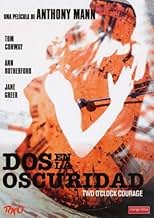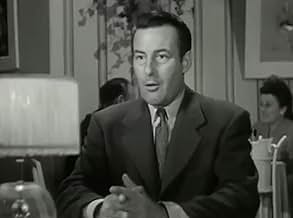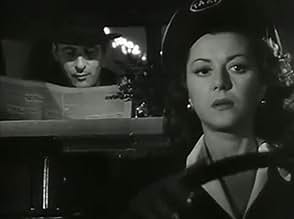IMDb रेटिंग
6.4/10
1.4 हज़ार
आपकी रेटिंग
अपनी भाषा में प्लॉट जोड़ेंA confused man with a gash on his head stumbles into the taxi cab of Patty Mitchell. He says that he can't recall his own name, any facts about his life or even what he was doing before he g... सभी पढ़ेंA confused man with a gash on his head stumbles into the taxi cab of Patty Mitchell. He says that he can't recall his own name, any facts about his life or even what he was doing before he got in the cab.A confused man with a gash on his head stumbles into the taxi cab of Patty Mitchell. He says that he can't recall his own name, any facts about his life or even what he was doing before he got in the cab.
- निर्देशक
- लेखक
- स्टार
Jane Greer
- Helen Carter
- (as Bettejane Greer)
Chester Clute
- Mr. Daniels
- (बिना क्रेडिट के)
Tom Coleman
- Waiter
- (बिना क्रेडिट के)
Harold De Becker
- Wilbur Judson (Dilling's Butler)
- (बिना क्रेडिट के)
Jack Deery
- Club Patron
- (बिना क्रेडिट के)
Christian Drake
- Assistant Editor
- (बिना क्रेडिट के)
Eddie Dunn
- Policeman at Clothing Store
- (बिना क्रेडिट के)
Sarah Edwards
- Mrs. Tuttle (Patty's Landlady)
- (बिना क्रेडिट के)
Franklyn Farnum
- Club Patron
- (बिना क्रेडिट के)
Charles Fogel
- Club Patron
- (बिना क्रेडिट के)
फ़ीचर्ड समीक्षाएं
Catch that noirish opening—Ted (Conway) wandering around in the fog with an even bigger fog inside his head, not knowing who he is or where he came from. Good thing girl cabbie (it's still war time) Patty (Rutherford) helps him out since the cops think he's murdered someone. These look like classic elements of noir, especially with master of the genre Anthony Mann in charge. But this is early in his career when he was still doing programmers.
There may be some interest here for film historians since the movie appears to straddle two genres— the humorous murder mysteries of the 30"s and early 40's and the emerging noir crime dramas of the post-war period. Note how Mann uses a noirish close-up to dramatize Ted's recovering memory. Looks like his darker artistic side is looking for opportunities to surface.
Still, thick-headed cop (Parnell) and fast-talking reporter (Lane) remain anchored in Charlie Chan's and Falcon's of the earlier period. But however you cut it, the movie's still a fun diversion, with a bouncy Rutherford, a polished Conway, and a pay-me-by-the-word Lane. Just don't try to figure out the mystery. I lost track somewhere between the butler-did-it and the gorgeous Jane Greer's revealing gowns.
There may be some interest here for film historians since the movie appears to straddle two genres— the humorous murder mysteries of the 30"s and early 40's and the emerging noir crime dramas of the post-war period. Note how Mann uses a noirish close-up to dramatize Ted's recovering memory. Looks like his darker artistic side is looking for opportunities to surface.
Still, thick-headed cop (Parnell) and fast-talking reporter (Lane) remain anchored in Charlie Chan's and Falcon's of the earlier period. But however you cut it, the movie's still a fun diversion, with a bouncy Rutherford, a polished Conway, and a pay-me-by-the-word Lane. Just don't try to figure out the mystery. I lost track somewhere between the butler-did-it and the gorgeous Jane Greer's revealing gowns.
Incongruously lighthearted early noir from Mann, involving a familiar premise (the film is actually a remake of the obscure TWO IN THE DARK [1936]) an amnesiac finds himself the chief suspect in a murder case and, while attempting to trace his identity, he also contrives to expose the guilty party. The lead role is played by Tom Conway, not the most likely noir hero perhaps his overall stilted performance suffers most when striving for comedy; much more natural (and appealing) is Ann Rutherford as the spirited female cabbie helping him out, even if she's just as much at odds with established genre conventions!
The plot is fairly convoluted: also involved, among others, are Lester Matthews (from THE RAVEN and WEREWOLF OF London {both 1935}), Jean Brooks (from the Val Lewton-produced THE LEOPARD MAN and THE SEVENTH VICTIM {both 1943}) and Jane Greer (soon to graduate to full-fledged femme fatale with OUT OF THE PAST [1947]); just as prominent, however, albeit merely for comic-relief purposes are a Police Inspector and a nosy reporter (who gets on his boss' nerves when he keeps changing the scoop i.e. the identity of the murderer). All in all, this emerged a pleasant and trim 66 minutes but, clearly, a very minor footnote in the genre and the career of one of its most notable exponents.
The plot is fairly convoluted: also involved, among others, are Lester Matthews (from THE RAVEN and WEREWOLF OF London {both 1935}), Jean Brooks (from the Val Lewton-produced THE LEOPARD MAN and THE SEVENTH VICTIM {both 1943}) and Jane Greer (soon to graduate to full-fledged femme fatale with OUT OF THE PAST [1947]); just as prominent, however, albeit merely for comic-relief purposes are a Police Inspector and a nosy reporter (who gets on his boss' nerves when he keeps changing the scoop i.e. the identity of the murderer). All in all, this emerged a pleasant and trim 66 minutes but, clearly, a very minor footnote in the genre and the career of one of its most notable exponents.
This came before Anthony Mann's famous, unique and quirky noir. By the time it was made, there had already been many authentic films noir. However, this updates what had been a formula throughout the thirties: the romantic/comic/mystery. There is romance. There is some comedy. But instead of mystery: We have here a true film noir. (The difference between this and other entries in the genre makes the importance of a good director very clear.) It begins with Tom Conway, in an excellent performance, looking at a sign noting an intersection of two streets. He doesn't know where there are, where he is. Or, even, who he is. Amnesia, yes indeed.
Now the comedy: Ann Rutherford, a female cab driver, happens by and helps him out. She calls her taxi Harry and, later, people get confused and think Harry might be the name of a suspect.
Though this has its light moments, it is a dark little movie. (And little it is, at just a bit longer than an hour.) We have a comic newspaperman and a semi-comic police officer. But we have some genuine bad guys too, and some women who are right out of the noir canon as well.
Among these is Jane Greer in a very early appearance. Though her role is small, she grabs out attention. The camera loves her, almost in the way it was to love a very different sort of performer: Marilyn Monroe. Though Greer doesn't have a lot to do or a whole lot of screen time, when she's around, we can't take our eyes off her. Now, there was real (and sadly underused) star!
Now the comedy: Ann Rutherford, a female cab driver, happens by and helps him out. She calls her taxi Harry and, later, people get confused and think Harry might be the name of a suspect.
Though this has its light moments, it is a dark little movie. (And little it is, at just a bit longer than an hour.) We have a comic newspaperman and a semi-comic police officer. But we have some genuine bad guys too, and some women who are right out of the noir canon as well.
Among these is Jane Greer in a very early appearance. Though her role is small, she grabs out attention. The camera loves her, almost in the way it was to love a very different sort of performer: Marilyn Monroe. Though Greer doesn't have a lot to do or a whole lot of screen time, when she's around, we can't take our eyes off her. Now, there was real (and sadly underused) star!
A rather rushed whodunit, with the plot weaving all over the place littering the screen with suspects, motives and distractions. At the end we have an anti-climax solution followed by the real killer being revealed. Bewildering? Thankfully Mann's direction is solid and the main leads Tom Conway and Ann Rutherford do a good job putting over the somewhat unlikely plot.
The Noir Festival programmer at the American Cinematheque in his comments before the screening (where I saw this gem) quipped like many RKO b pictures this one has story contrivances that cut costs like most of the characters staying in the same hotel. But it gets a bit much when Conway's character gives the police the slip to search a room elsewhere in the hotel which results in a fight that the cops can hear through the ceiling. Talk about plot contrivance!
The Noir Festival programmer at the American Cinematheque in his comments before the screening (where I saw this gem) quipped like many RKO b pictures this one has story contrivances that cut costs like most of the characters staying in the same hotel. But it gets a bit much when Conway's character gives the police the slip to search a room elsewhere in the hotel which results in a fight that the cops can hear through the ceiling. Talk about plot contrivance!
Remake of Two in the Dark from RKO starring the unlikely duo of Tom Conway and Ann Rutherford. Conway plays a guy with a head wound and amnesia who searches for the truth about who he is and whether or not he committed murder. Rutherford is the spunky female cabbie who helps him. This is an entertaining enough picture. Nothing exceptional but a good time-passer. Conway, debonair as ever, is the kind of actor they just don't make anymore. Adorable Ann Rutherford is a little miscast as a street-smart cabbie. This is a part more suited for a Farrell, Blondell, or Sothern. Rutherford's just too sweet. Still she's always a treat to watch, even if it does feel a bit like she's trying on her big sister's clothes. Conway/Rutherford chemistry isn't exactly sizzling, either. Also featuring noir great Jane Greer in a small part and RKO favorite Jean Brooks, who was in quite a few Tom Conway films during the 40s. Directed by Anthony Mann but you would never know it as it's a pretty routine B movie with no discernible style or craft to brag about.
क्या आपको पता है
- ट्रिवियाThis film marked the screen debut of Jane Greer, who was billed onscreen under her real name, Bettejane Greer. She played the role of "Helen Carter".
- गूफ़When the police attempt to enter Room 212 near the end, three bullets are shot through the door from inside the room. After the police gain access and the door swings open, the holes are absent. When it then swings back to reveal Barbara Borden, the holes are back.
- कनेक्शनReferenced in This Movie Must Die!: Two in the Dark (1936) vs. Two O'Clock Courage (1945) (2021)
टॉप पसंद
रेटिंग देने के लिए साइन-इन करें और वैयक्तिकृत सुझावों के लिए वॉचलिस्ट करें
- How long is Two O'Clock Courage?Alexa द्वारा संचालित
विवरण
- चलने की अवधि1 घंटा 8 मिनट
- रंग
- पक्ष अनुपात
- 1.37 : 1
इस पेज में योगदान दें
किसी बदलाव का सुझाव दें या अनुपलब्ध कॉन्टेंट जोड़ें



































